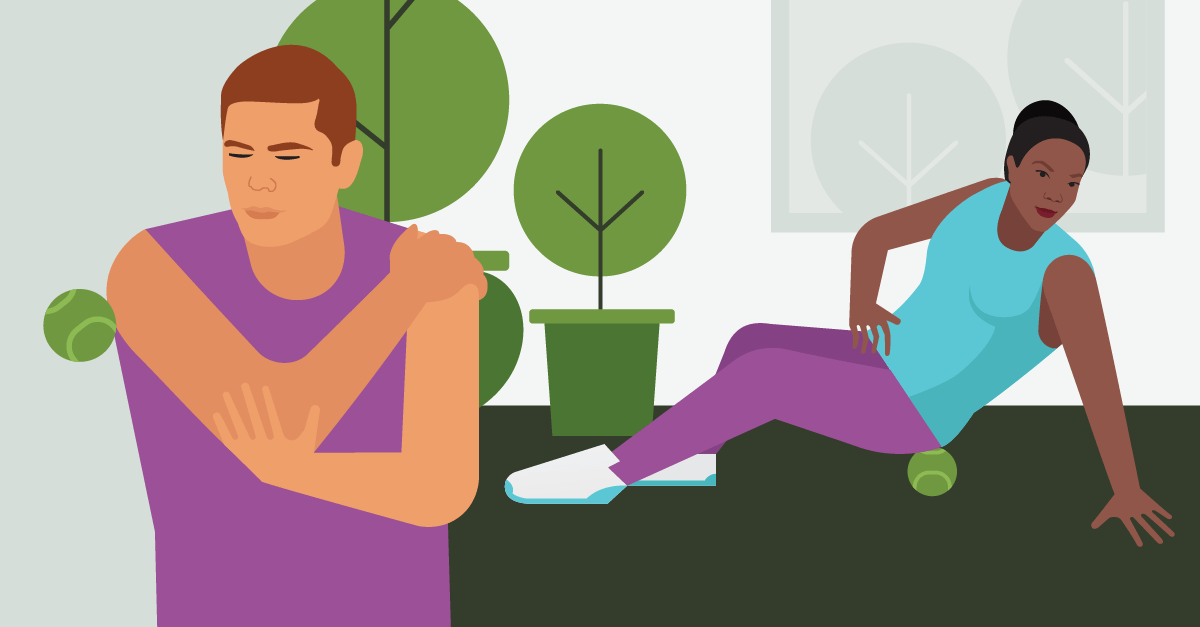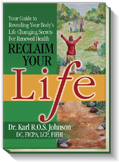Pain comes from all different sources—and that includes exercise. Sometimes you push it, for example if you go on a run and go longer than you ever have before. Sometimes you push it by adding weights to a routine, or even just doing something that’s new to you. Regardless, that pain can make movement and continuing your routine difficult. That’s why it’s helpful to find easy, inexpensive, accessible ways to make pain lessen more quickly. Enter the humble tennis ball.
A tennis ball is an excellent tool because it’s small and easy to use and a great way to get specifically at those trigger points—those sources of pain that might be holding tightness, for example. You can keep a tennis ball on hand anywhere, and in just a minute or two complete an exercise that opens up an area and lets you get on with life. What are those routines and how can you do them? This graphic explains it.

Tennis balls are great on the court, or to use for playing fetch with Rover. But, there’s more to these bright, fuzzy balls than just recreation. They’re also the perfect tool to relieve muscle pain. Plus, they’re inexpensive, convenient, and portable. Want to learn how to press and roll away the pain with the help of a tennis ball? Read on for our detailed guide.
What is SMR?
Many of us experience knots and tenderness in our muscles, known as trigger points. A tennis ball and a technique known as self-myofascial release (SMR) can help alleviate discomfort. (If pain persists, it’s a good idea to make an appointment with a specialist or massage therapist.)
Fascia, the connective tissue that helps the body move, provides the freedom of movement we rely on to play sports, dance, and for general activity. When fascia has areas of dysfunction it is often described as being knotted, ropy, or having adhesions or scar tissue. This is a malalignment of tissue due to poor movement patterns, emotional distress (say you are tense at work), injury, or trauma.
SMR is a mechanism used to release the tissue to restore natural movement patterns. You can decide whether you need to perform SMR in certain areas of tissue by noticing tender trigger points.
Another way to define areas that may need SMR is to test if the skin glides over subcutaneous tissue, which is the innermost layer of skin. You’ll notice this gliding around areas that are scarred, such as where a cesarean section or knee surgery was performed. It also happens in dense areas of tissue such as knots you can move around beneath the skin.
Dense tissue areas may not necessarily be painful. People who squat heavy may have dense spinal erectors and IT bands. It is important to maintain this tissue, but some tissue density isn’t a bad thing.
How to Know if SMR Works
It’s important to test your movement and range of motion before and after performing SMR. If you feel a specific movement pattern, such as a squat, is inhibited, then perform a bodyweight squat prior to your SMR treatment. Once you finish rolling on the tennis ball, test your range of motion again.
Take note of whether you move better, have reduced pain, and/or experience reduced tension. A single treatment using a tennis ball for SMR may not do the trick. If you are dealing with long-term fascia dysfunction, you may need to continue with treatments for several days. As always, follow up with your healthcare provider.
Masseter muscle
The masseter muscle is the primary chewing muscle that runs along the side of the jaw. Teeth clenching and grinding can cause tension in this area, leading to headaches, temporomandibular joint (TMJ) syndrome, and toothaches.
● Place the tennis ball on an elevated surface such as a thick textbook or yoga block.
● Lie on the ball with the side of your face in the area where the upper and lower jaw meet.
● Open and close the mouth, allowing the ball to sink in to any tense areas.
● Go for 30 to 60 seconds, and then repeat on the other side.
Plantar fascia
Plantar fascia is the thick band of tissue that covers the bone in the bottom of the foot. You may experience tenderness and pain in this area after a run or long hike.
● Place a tennis ball on the ground and remove your shoes.
● Place the sole of the foot on the tennis ball. Hold on to a support for balance if needed.
● Bear weight on the foot that is on the ball. Roll back and forth along the plantar fascia.
● Repeat the motion for 30 to 60 seconds, and then switch sides.
Piriformis
The piriformis is a muscle that originates in the front of the sacrum and inserts into the top of the femur. It is often the origin of glute pain that irritates the sciatic nerve. Its job is to externally rotate the hips and, to a certain degree, internally rotate them.
● Place a tennis ball under one hip.
● Sit on the ball with your hands behind your torso and knees bent.
● Roll back and forth over the piriformis. Alter the angle of your body to hit the piriformis in different areas.
● Roll for 30 to 60 seconds, and then switch the other side.
Pectorals
The pectoralis major originates in the sternum and clavicle, and inserts into the humerus. This muscle is responsible for horizontal abduction and internal rotation of the shoulder. This muscle can become stiff and short due to poor posture or overtraining. Tightness is noted by rounded shoulders.
● Stand by the wall, placing a tennis ball on the wall at shoulder height.
● Push the pecs into the ball to hold it in place.
● Roll back and forth, then side to side.
● Roll for 30 to 60 seconds, and repeat on the other side.
Posterior shoulder
The posterior shoulder provides stability to the shoulder joint. It often experiences scarring and adhering or tightness that can lead to range of motion loss.
● Stand next to a wall with the tennis ball placed at shoulder height.
● Push the back of the shoulder beneath the scapula into the ball.
● Roll back and forth, working in small sections.
● Roll for 30 to 60 seconds, and switch to the other side.
A final word on tennis ball SMR
It’s better to decrease the surface area you roll rather than to increase the pressure. If you find a spot that needs a little extra care, hang out there for more time. Don’t roll yourself into a heap of pain. SMR is meant to provide relief, not test your pain threshold. Short sessions each day are better than long grueling sessions that leave you bruised or in agony.
About the Author:
Kellie Davis is an author and personal trainer. As a fitness writer and personal trainer, she is known for helping hundreds of women achieve optimal health through her innovative fitness programs designed for those with a busy lifestyle.

If you found value in this article, please use the social sharing icons at the top of this post and please share with those you know who are still suffering with chronic health challenges or autoimmune issues despite having medical managment. Thank you, help me reach more people so they may regain their zest for living!
Always remember one of my mantras., "The more you know about how your body works, the better you can take care of yourself."
For more details about the natural approach I take with my patients, take a look at the book I wrote entitled: Reclaim Your Life; Your Guide To Revealing Your Body's Life-Changing Secrets For Renewed Health. It is available in my office or at Amazon and many other book outlets. If you found value in this article, please use the social sharing icons at the top of this post and please share with those you know who are still suffering with chronic health challenges, despite receiving medical management. Help me reach more people so they may regain their zest for living! Thank you!
ALL THE BEST – DR. KARL R.O.S. JOHNSON, DC – DIGGING DEEPER TO FIND SOLUTIONS
Infographic by Pain Management and Injury Relief


